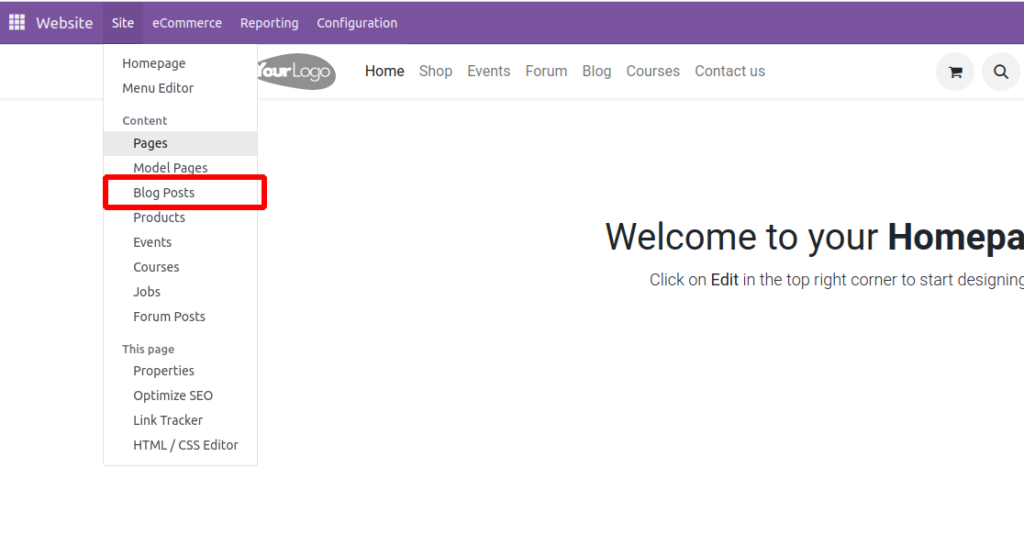For SEO, branding, and user experience, it is absolutely vital to improve your URL structure if your website or eCommerce site is ran with Odoo. An organized URL improves search engine ratings and simplifies user navigation. We will show you how to change the URL blog/rr-events-4/rr-events-42 in Odoo while keeping redirects in place to avoid SEO damage and broken links in this guide.

Why do you have to alter Odoo’s URLs?
SEO Optimization
Relevant URLs that help page search results are preferred. Search engines like brief, informative ones.
Readability and Branding
A personalized URL helps users to recall and link your brand.
Preventing 404 Errors
Updating URLs stops 404 errors and preserves traffic since site construction change changes.
More User-Friendly
A straightforward and short URL betters navigation and trustworthiness.
How to Change the URL in Odoo
1. Access your Odoo Backend by logging in
First, log in with admin rights into your Odoo backend.
2. Go to the Website Module
Once logged in, visit the Website Module from the Odoo dashboard, where you will be able to handle pages and blog entries.
3. Find the Blog Entry or Web Chapter
For blog entries, go to the website section under blog. Visit the Web Pages part of the website for general pages.
4. Rework the Blog Post or Site
Choose the particular post or page you would like to change.
5. Change the URL
Look for the URL field under Page Configuration or Blog Settings. Replace the existing URL blog/rr-events-4/rr-events-42 with a more suitable and SEO-friendly one, such as blog/new-event-42.
6. Keep Changes
After the URL is updated, save your edits to make sure they take place.
7. Implement a 301 Redirect (Strongly Recommended)
Should the former URL have been backlink or search engine indexed, configure a redirect meant to prevent broken links:
- Go to Website > Configuration > Redirects.
- From blog/rr-events-4/rr-events-42, set a 301 redirect to blog/new-event-42.
- This guarantees search engines and users are sent gracefully to the fresh URL.
8. Evaluate the Updated URL
After implementing the changes, check the new URL by typing it into a browser and seeing.
Best Practices for SEO-Optimized URLs
Factorizing
Good Practice
Extent
Conciseness and relevance are important for URLs.
Hyphens
Separate words using hyphens (-).
Stay Clear from Unusual Symbols
Use letters, numerals, and hyphens only.
Consistent Nature
Keep a consistent URL format throughout your site.
Keyword Inclusion
Provide pertinent keywords for SEO advantages.
Common Errors to Circumvent
- Using long or difficult URLs.
- Not enough creation of good redirects.
- Changing URLs constantly for no reason.
- Using underlines or special symbols.
Conclusion
Changing URLs in Odoo is a basic yet vital first move in improving your website. Following the directions given above will guarantee a seamless migration to a URL system friendly to search engine optimization. Always create redirects to protect traffic and ratings. Applying these best practices will improve your website’s user experience and visibility.
Frequently Asked Questions (FAQs)
1. Why should I change my blog URL in Odoo?
Changing your blog URL improves SEO, enhances user experience, and ensures better branding. A clean and optimized URL structure also makes it easier for search engines to index your page.
2. Will changing my URL affect my website ranking?
Yes, it can temporarily impact rankings, but setting up a proper 301 redirect ensures that search engines and users are directed to the new URL without losing SEO value.
3. How do I create a 301 redirect in Odoo?
Go to Website > Configuration > Redirects, then add a new redirect from the old URL to the new URL. This ensures smooth redirection and prevents broken links.
4. Can I change the URL structure for multiple blog posts at once?
Odoo does not support bulk URL changes directly. You will need to manually edit each blog post URL and set up redirects for each change.
5. What happens if I don’t set up a redirect after changing the URL?
If you don’t set up a redirect, users and search engines accessing the old URL will get a 404 error, which negatively impacts SEO and user experience.
6. How do I ensure my new URL is SEO-friendly?
Use relevant keywords, keep it short, avoid special characters, and maintain a consistent structure. Also, separate words with hyphens (-) instead of underscores or spaces.
7. Can I revert back to my old URL after changing it?
Yes, but it is not recommended unless necessary. Frequent URL changes can confuse search engines and negatively affect SEO performance.



